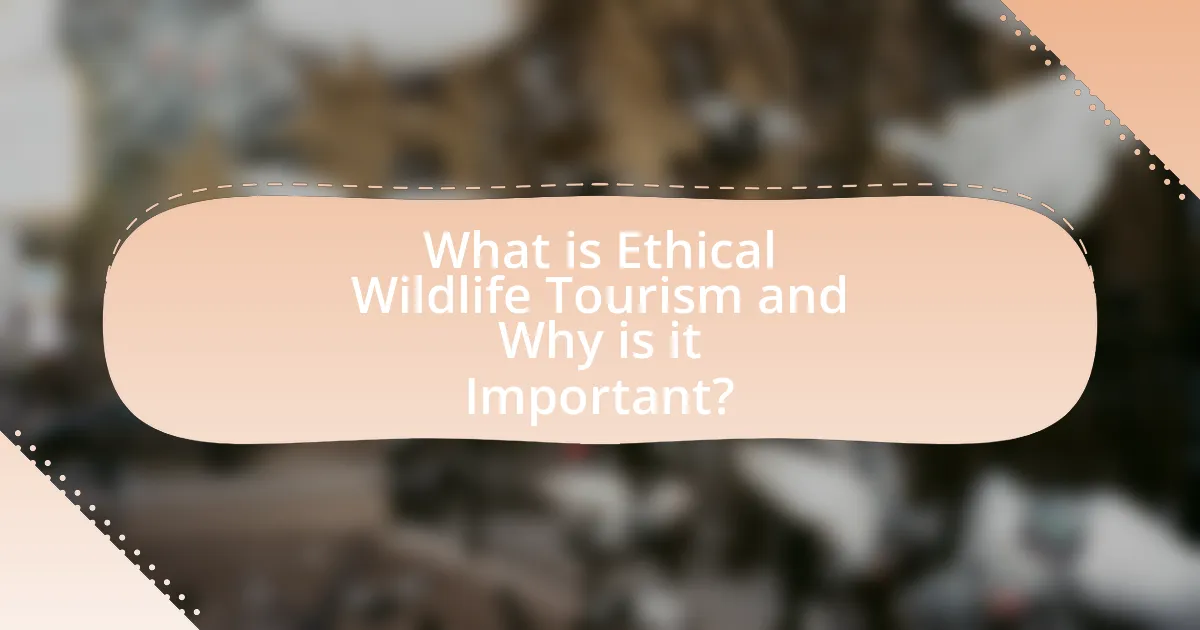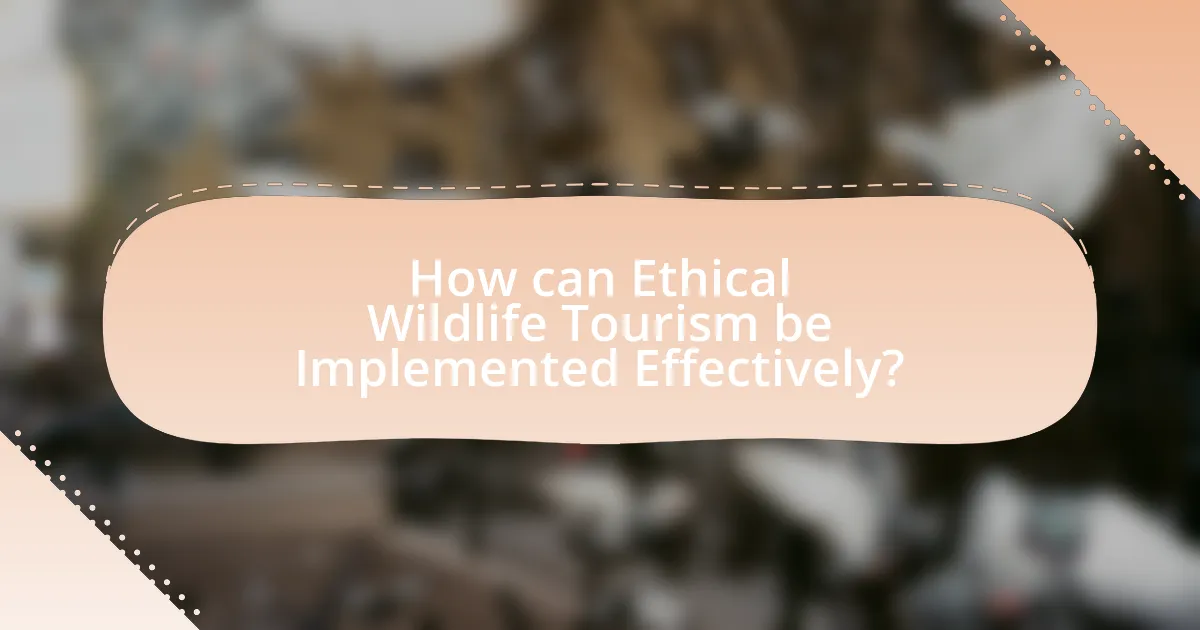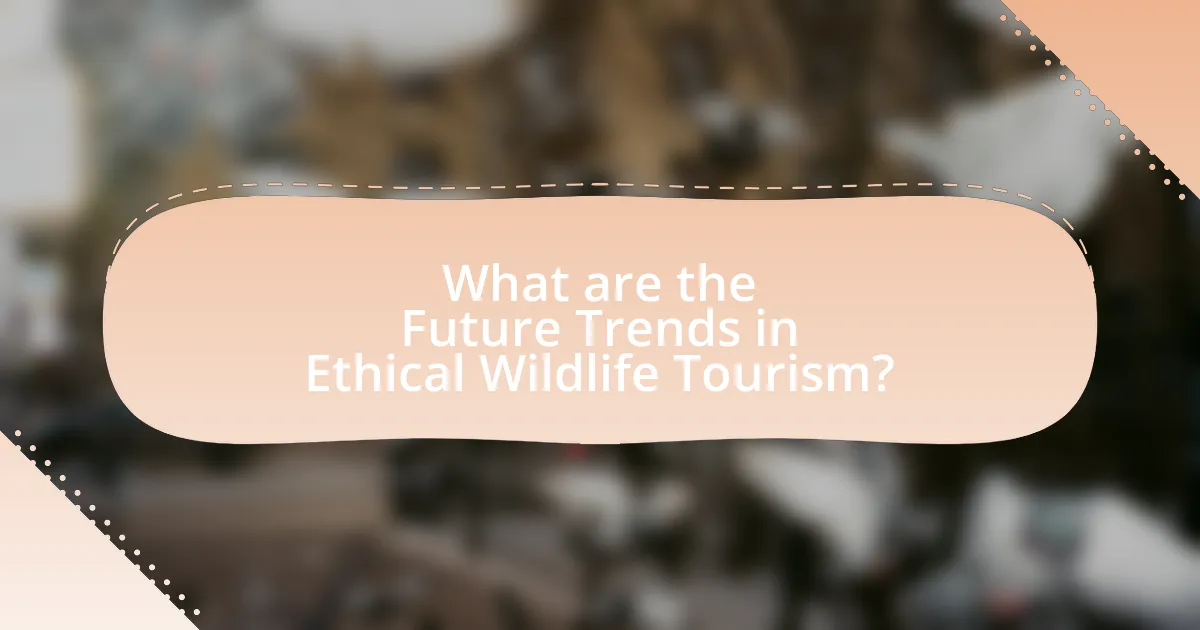Ethical wildlife tourism is a tourism approach that emphasizes the welfare of animals and their habitats while supporting conservation efforts. This article explores the significance of ethical wildlife tourism in promoting sustainable practices, protecting ecosystems, and benefiting local communities. It contrasts ethical tourism with traditional practices, outlines guiding principles, and discusses the potential risks of unethical tourism. Additionally, the article highlights the role of ethical wildlife tourism in conservation funding, habitat preservation, and community support, while addressing future trends and challenges in the industry. Practical steps for travelers and the importance of regulations and certifications in promoting ethical practices are also examined.

What is Ethical Wildlife Tourism and Why is it Important?
Ethical wildlife tourism is a form of tourism that prioritizes the welfare of animals and their habitats while promoting conservation efforts. This approach is important because it helps to minimize the negative impacts of tourism on wildlife, supports local communities, and raises awareness about conservation issues. For instance, ethical wildlife tourism often involves responsible practices such as observing animals in their natural habitats without disturbing them, which can lead to increased funding for conservation initiatives and habitat protection. Studies have shown that ethical tourism can contribute significantly to local economies while ensuring that wildlife populations are sustained and ecosystems remain intact.
How does Ethical Wildlife Tourism differ from Traditional Wildlife Tourism?
Ethical Wildlife Tourism prioritizes the welfare of animals and their habitats, while Traditional Wildlife Tourism often focuses on profit and entertainment, sometimes at the expense of animal well-being. Ethical Wildlife Tourism emphasizes responsible practices, such as minimizing human impact and supporting conservation efforts, which can include funding for habitat preservation and community education. In contrast, Traditional Wildlife Tourism may involve activities like feeding or close encounters with animals that can lead to stress and harm. Studies have shown that ethical practices can enhance biodiversity conservation, as seen in initiatives that promote sustainable tourism in protected areas, thereby benefiting both wildlife and local communities.
What ethical principles guide Wildlife Tourism practices?
Ethical principles guiding Wildlife Tourism practices include conservation, respect for wildlife, community engagement, and sustainability. Conservation emphasizes the protection of wildlife habitats and species, ensuring that tourism activities do not harm ecosystems. Respect for wildlife involves minimizing human interference and allowing animals to behave naturally, which is crucial for their well-being. Community engagement ensures that local communities benefit economically and socially from tourism, fostering a sense of ownership and responsibility towards wildlife. Sustainability focuses on minimizing environmental impact and promoting practices that can be maintained long-term without depleting resources. These principles are essential for ensuring that wildlife tourism contributes positively to conservation efforts and local communities.
Why is the distinction between ethical and non-ethical tourism crucial for conservation?
The distinction between ethical and non-ethical tourism is crucial for conservation because ethical tourism promotes sustainable practices that protect wildlife and their habitats, while non-ethical tourism often leads to environmental degradation and harm to animal populations. Ethical tourism prioritizes the welfare of animals, supports local communities, and fosters conservation efforts, as evidenced by studies showing that responsible tourism can generate funding for wildlife protection initiatives. In contrast, non-ethical tourism can contribute to habitat destruction, exploitation of animals, and increased poaching, undermining conservation goals. Therefore, recognizing and supporting ethical tourism is essential for effective conservation strategies.
What role does Ethical Wildlife Tourism play in Conservation Efforts?
Ethical wildlife tourism plays a crucial role in conservation efforts by generating revenue that supports habitat preservation and wildlife protection initiatives. This form of tourism encourages sustainable practices, as it often involves local communities in conservation activities, thereby fostering a sense of stewardship over natural resources. For instance, a study by the World Wildlife Fund indicates that wildlife tourism can contribute up to 20% of the funding for conservation projects in certain regions, directly linking tourist spending to the protection of endangered species and their habitats. Additionally, ethical wildlife tourism raises awareness about conservation issues, educating tourists on the importance of biodiversity and the threats faced by wildlife, which can lead to increased advocacy and support for conservation policies.
How does Ethical Wildlife Tourism contribute to habitat preservation?
Ethical wildlife tourism contributes to habitat preservation by generating revenue that supports conservation initiatives. This form of tourism encourages local communities to protect their natural environments, as they benefit economically from preserving wildlife and habitats rather than exploiting them. For instance, a study by the World Wildlife Fund found that ecotourism can provide significant funding for protected areas, with some regions reporting up to 30% of their conservation budgets coming from tourism-related activities. This financial support enables the maintenance and restoration of habitats, ensuring the survival of various species and ecosystems.
In what ways does it support local communities and economies?
Ethical wildlife tourism supports local communities and economies by generating revenue through sustainable practices that prioritize conservation. This form of tourism creates jobs in guiding, hospitality, and conservation efforts, which directly benefits local residents. For instance, a study by the World Wildlife Fund indicates that wildlife tourism can contribute up to 20% of the GDP in some developing countries, providing essential funding for community projects and conservation initiatives. Additionally, ethical wildlife tourism encourages the preservation of natural habitats, which in turn sustains local livelihoods dependent on these ecosystems.
What are the potential risks of unethical wildlife tourism?
Unethical wildlife tourism poses significant risks, including habitat destruction, wildlife exploitation, and the spread of disease. Habitat destruction occurs when tourism activities lead to the degradation of natural environments, which can result in loss of biodiversity. For instance, the construction of tourist facilities often encroaches on wildlife habitats, disrupting ecosystems. Wildlife exploitation is evident when animals are taken from their natural habitats for entertainment purposes, leading to population declines; a study by the World Animal Protection found that 75% of wildlife attractions involve unethical practices. Additionally, unethical tourism can facilitate the spread of zoonotic diseases, as close interactions between tourists and wildlife increase the risk of disease transmission, exemplified by the COVID-19 pandemic’s link to wildlife markets. These risks highlight the urgent need for ethical practices in wildlife tourism to protect both animals and ecosystems.
How can unethical practices harm wildlife populations?
Unethical practices can significantly harm wildlife populations by leading to habitat destruction, poaching, and the disruption of natural behaviors. Habitat destruction, often caused by illegal logging or land conversion for agriculture, reduces the available space for wildlife, leading to population declines. Poaching directly decreases animal numbers, as species are hunted for their body parts, which can result in extinction for vulnerable species. Additionally, unethical tourism practices, such as feeding or disturbing animals, can alter their natural behaviors, making them more susceptible to predators and reducing their chances of survival. According to the World Wildlife Fund, illegal wildlife trade alone threatens over 7,000 species, highlighting the severe impact of these unethical practices on biodiversity.
What negative impacts can unethical tourism have on local ecosystems?
Unethical tourism can severely disrupt local ecosystems by causing habitat destruction, pollution, and wildlife disturbance. For instance, the construction of tourist facilities often leads to deforestation and loss of biodiversity, as seen in areas like the Amazon rainforest, where tourism development has contributed to significant habitat loss. Additionally, unethical practices such as littering and improper waste disposal can lead to soil and water pollution, harming both flora and fauna. Furthermore, the presence of tourists can stress wildlife, leading to altered behaviors and decreased reproductive success, as evidenced by studies showing that increased human activity can displace animals from their natural habitats.

How can Ethical Wildlife Tourism be Implemented Effectively?
Ethical wildlife tourism can be implemented effectively by establishing strict guidelines that prioritize animal welfare, local community involvement, and environmental sustainability. Organizations should develop and enforce regulations that prevent exploitation and ensure that wildlife is observed in their natural habitats without disturbance. For instance, the International Ecotourism Society emphasizes the importance of responsible travel practices that benefit conservation and local cultures. Additionally, engaging local communities in tourism initiatives fosters economic benefits and encourages conservation efforts, as seen in successful models like community-based tourism in Namibia, which has led to increased wildlife populations and habitat preservation.
What best practices should be followed in Ethical Wildlife Tourism?
Best practices in ethical wildlife tourism include prioritizing animal welfare, supporting local communities, and promoting conservation efforts. Ensuring that wildlife experiences do not harm animals or their habitats is crucial; for instance, organizations should avoid activities that exploit animals, such as riding elephants or performing animals. Supporting local communities through fair employment and sustainable practices enhances economic benefits while fostering conservation. Additionally, promoting awareness and education about wildlife conservation can lead to more responsible tourism behaviors. According to a study by the World Wildlife Fund, ethical tourism practices can significantly contribute to conservation funding and habitat protection, demonstrating the positive impact of responsible tourism on wildlife preservation.
How can tour operators ensure ethical interactions with wildlife?
Tour operators can ensure ethical interactions with wildlife by adhering to strict guidelines that prioritize animal welfare and conservation. These guidelines include avoiding activities that exploit or harm animals, such as feeding or touching wildlife, and promoting responsible viewing practices that maintain a safe distance. Research indicates that ethical wildlife tourism can contribute to conservation efforts by generating funding for habitat protection and raising awareness about endangered species. For instance, a study published in the Journal of Sustainable Tourism highlights that responsible tourism practices can lead to increased local support for conservation initiatives, demonstrating the positive impact of ethical interactions on wildlife preservation.
What role do regulations and certifications play in promoting ethical tourism?
Regulations and certifications are crucial in promoting ethical tourism by establishing standards that ensure responsible practices in the industry. These frameworks guide businesses in minimizing negative impacts on wildlife and local communities, thereby fostering sustainable tourism. For instance, certifications like the Global Sustainable Tourism Council (GSTC) criteria provide benchmarks for environmental and social responsibility, encouraging operators to adopt practices that protect ecosystems and respect cultural heritage. Furthermore, regulations often mandate compliance with wildlife protection laws, which can lead to reduced exploitation and better conservation outcomes. Studies have shown that destinations with strong regulatory frameworks and recognized certifications experience higher visitor satisfaction and increased conservation funding, demonstrating the effectiveness of these measures in promoting ethical tourism.
How can travelers contribute to Ethical Wildlife Tourism?
Travelers can contribute to Ethical Wildlife Tourism by choosing responsible tour operators that prioritize animal welfare and conservation. By selecting companies that adhere to ethical practices, such as avoiding activities that exploit wildlife or disrupt their natural habitats, travelers support sustainable tourism initiatives. Research indicates that ethical wildlife tourism can lead to increased funding for conservation efforts, as responsible operators often reinvest profits into local communities and wildlife protection programs. For instance, a study published in the Journal of Sustainable Tourism highlights that ethical tourism can generate up to 30% more revenue for conservation projects compared to traditional tourism models.
What should travelers look for when choosing wildlife tours?
Travelers should prioritize ethical practices when choosing wildlife tours. This includes ensuring that the tour operator follows guidelines that protect animal welfare, such as avoiding activities that exploit wildlife or disrupt their natural habitats. Research indicates that ethical wildlife tourism can contribute to conservation efforts by generating funds for habitat preservation and promoting awareness about endangered species. For instance, a study by the World Wildlife Fund highlights that responsible tourism can lead to a 20% increase in funding for conservation projects in areas frequented by tourists. Therefore, selecting tours that emphasize ethical treatment of animals and support local conservation initiatives is crucial for travelers.
How can travelers educate themselves about ethical practices?
Travelers can educate themselves about ethical practices by researching and engaging with reputable organizations focused on wildlife conservation and ethical tourism. For instance, organizations like the World Wildlife Fund and the International Ecotourism Society provide resources, guidelines, and educational materials that highlight best practices in ethical wildlife tourism. Additionally, travelers can read books, articles, and studies on the impact of tourism on wildlife and ecosystems, such as “Ecotourism and Sustainable Development” by David A. Fennell, which discusses the principles of responsible travel. Engaging with local communities and participating in workshops or tours led by ethical operators also enhances understanding of sustainable practices and their importance in conservation efforts.

What are the Future Trends in Ethical Wildlife Tourism?
Future trends in ethical wildlife tourism include increased focus on sustainability, community involvement, and technology integration. As travelers become more environmentally conscious, wildlife tourism operators are adopting practices that minimize ecological footprints, such as using renewable energy sources and reducing waste. Community involvement is also gaining traction, with local populations participating in tourism initiatives, ensuring that they benefit economically and socially from wildlife conservation efforts. Furthermore, technology is playing a significant role, with virtual reality and mobile applications enhancing visitor experiences while promoting conservation education. These trends are supported by a growing body of research indicating that ethical wildlife tourism can lead to improved conservation outcomes and community welfare.
How is technology shaping the future of Ethical Wildlife Tourism?
Technology is shaping the future of Ethical Wildlife Tourism by enhancing conservation efforts through data collection, monitoring, and visitor engagement. Advanced tools such as drones and camera traps allow researchers to track wildlife populations and behaviors more accurately, leading to better-informed conservation strategies. For instance, a study published in the journal “Conservation Biology” highlights how satellite tracking has improved the understanding of migratory patterns, which is crucial for habitat protection. Additionally, mobile applications and virtual reality experiences are being developed to educate tourists about wildlife conservation, fostering a sense of responsibility and ethical behavior among visitors. These technological advancements not only improve the sustainability of wildlife tourism but also contribute to the overall effectiveness of conservation initiatives.
What innovations are being developed to enhance ethical practices?
Innovations being developed to enhance ethical practices in wildlife tourism include the use of technology for monitoring animal welfare and habitat conditions. For instance, remote sensing and drone technology are increasingly utilized to track wildlife movements and assess ecosystem health, ensuring that tourism activities do not negatively impact these environments. Additionally, mobile applications are being created to educate tourists about ethical practices and promote responsible behavior while interacting with wildlife. Research indicates that these technological advancements not only improve compliance with ethical standards but also foster greater awareness among tourists, leading to more sustainable tourism practices.
How can virtual experiences impact wildlife conservation efforts?
Virtual experiences can significantly enhance wildlife conservation efforts by increasing public awareness and engagement. These immersive experiences allow individuals to connect with wildlife in a meaningful way, fostering empathy and understanding of conservation issues. For instance, studies have shown that virtual reality (VR) experiences can lead to a 30% increase in participants’ willingness to support conservation initiatives financially. By providing realistic simulations of wildlife habitats and the challenges they face, virtual experiences can motivate individuals to take action, such as participating in conservation programs or advocating for policy changes.
What challenges does Ethical Wildlife Tourism face moving forward?
Ethical wildlife tourism faces significant challenges moving forward, primarily including habitat destruction, climate change, and the risk of wildlife exploitation. Habitat destruction, driven by urbanization and agricultural expansion, threatens the natural environments that wildlife relies on, making it difficult for tourism to promote conservation effectively. Climate change further exacerbates these issues by altering ecosystems and animal behaviors, which can lead to decreased wildlife populations and biodiversity. Additionally, the risk of exploitation arises when tourism prioritizes profit over ethical practices, potentially leading to harmful interactions between tourists and wildlife. These challenges necessitate a concerted effort from stakeholders to ensure that ethical wildlife tourism can contribute positively to conservation efforts.
How can the industry address issues of sustainability and over-tourism?
The industry can address issues of sustainability and over-tourism by implementing responsible tourism practices that prioritize environmental conservation and community engagement. For instance, adopting measures such as limiting visitor numbers in sensitive areas can help reduce ecological impact, as evidenced by the success of visitor caps in places like Galápagos Islands, which saw a 30% decrease in tourist numbers leading to improved wildlife populations. Additionally, promoting eco-friendly accommodations and local experiences fosters economic benefits for communities while minimizing carbon footprints. Research from the World Travel & Tourism Council indicates that sustainable tourism can generate up to 10% of global GDP, highlighting its potential for economic growth alongside conservation efforts.
What strategies can be employed to combat misinformation about wildlife tourism?
To combat misinformation about wildlife tourism, implementing educational campaigns that promote accurate information is essential. These campaigns can utilize social media platforms, websites, and community outreach to disseminate facts about ethical wildlife tourism practices and their benefits for conservation. For instance, studies have shown that informed tourists are more likely to engage in responsible behaviors that support wildlife conservation, as evidenced by a 2019 survey conducted by the World Wildlife Fund, which found that 75% of participants changed their travel habits after receiving accurate information about wildlife tourism’s impact. Additionally, collaborating with local communities and conservation organizations can help create a unified message that counters false narratives and highlights the positive effects of ethical wildlife tourism on both wildlife and local economies.
What practical steps can individuals take to support Ethical Wildlife Tourism?
Individuals can support Ethical Wildlife Tourism by choosing to visit accredited wildlife sanctuaries and eco-friendly lodges that prioritize animal welfare and conservation. By selecting these establishments, individuals contribute to responsible tourism practices that minimize harm to wildlife and their habitats. Research indicates that ethical tourism can lead to increased funding for conservation efforts; for example, a study published in the Journal of Sustainable Tourism found that ethical wildlife tourism generates significant revenue for local communities, which can be reinvested into conservation initiatives. Additionally, individuals can educate themselves and others about the impacts of wildlife tourism, advocate for policies that protect wildlife, and support organizations that promote ethical practices in the industry.